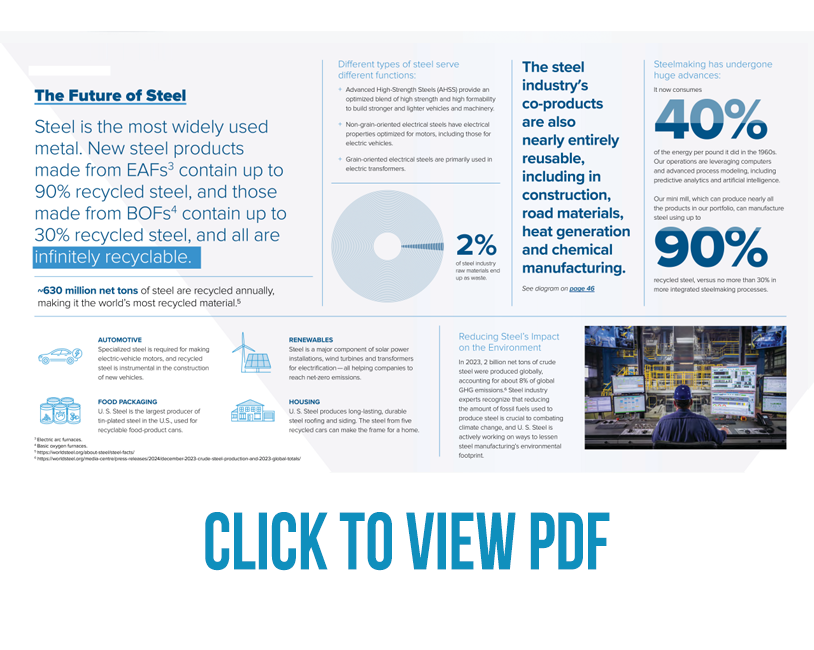The Future of Steel - www.ussteel.com
Introduction
The Future of Steel
- Steel is the most widely used metal. New steel products made from electric arc furnaces contain up to 90% recycled steel, and those made from basic oxygen furnaces contain up to 30% recycled steel, and all are infinitely recyclable.
- ~630 million net tons of steel are recycled annually, making it the world’s most recycled material. See more: https://worldsteel.org/about-steel/steel-facts/
- Different types of steel serve different functions:
- Advanced High-Strength Steels (AHSS) provide an optimized blend of high strength and high formability to build stronger and lighter vehicles and machinery.
- Non-grain-oriented electrical steels have electrical properties optimized for motors, including those for electric vehicles. Grain-oriented electrical steels are primarily used in electric.
Steelmaking has undergone huge advances: It now consumes40%of the energy per pound it did in the 1960s. Our operations are leveraging computers and advanced process modeling, including predictive analytics and artificial intelligence. | Our mini mill, which can produce nearly all the products in our portfolio, can manufacture steel using up to90%recycled steel, versus no more than 30% in more integrated steelmaking processes. |
AUTOMOTIVE
Specialized steel is required for making electric- vehicle motors, and recycled steel is instrumental in the construction of new vehicles.
RENEWABLES
Steel is a major component of solar power installations, wind turbines and transformers for electrification — all helping companies to reach net-zero emissions.
HOUSING
U. S. Steel produces long-lasting, durable steel roofing and siding. The steel from five recycled cars can make the frame for a home.
FOOD PACKAGING
U. S. Steel is the largest producer of tin-plated steel in the U.S., used for recyclable food-product cans.
Reducing Steel’s Impact on the Environment
In 2023, 2 billion net tons of crude steel were produced globally, accounting for about 8% of global GHG emissions.* Steel industry experts recognize that reducing the amount of fossil fuels used to produce steel is crucial to combating climate change, and U. S. Steel is actively working on ways to lessen steel manufacturing’s environmental footprint.
Steel and Sustainability
*https://worldsteel.org/about-steel/steel-facts/
Lightweight Strength
New and better ways of making modern steel are invented every year. Advanced High-Strength Steel (AHSS) is critical to increasing the fuel efficiency of automobiles and to reducing emissions. Thanks to the strength and light weight of modern steel, high-rise buildings can be built today with half the steel used in the 1930s for buildings of equal size.
Manufacturing Flexibility
Components may be cold stamped or hot formed into intricate shapes and structures, and the steel can be joined by many techniques, including welding and brazing, gluing and even lock seaming. This flexibility enables benefits such as cost savings, accelerated speed to market, and improved versatility.
Preserving Water
Around 90% of water used in the steel industry is cleaned, cooled and returned to its source.* Most of the loss is due to evaporation. The water returned to rivers and other sources is often cleaner than when it was extracted.**
*https://worldsteel.org/about-steel/key-messages/steel-core-green-economy/
**https://worldsteel.org/media-centre/blog/2020/climate-steel-industry-water-scarcity/
Saving Energy
The energy used to produce a ton of steel has been reduced by around 60% in the last 50 years.*
*https://worldsteel.org/steel-topics/raw-materials/
Reducing CO2 Emissions
Emissions levels from producing steel have dropped from more than two metric tons of CO2 per ton of steel produced (integrated) to less than half a ton of CO2 per ton of steel produced in a mini mill when considering Scope 1 and Scope 2 emission sources. In the future, these amounts could fall even more by using emission free electricity and hydrogen fuel as energy sources.
INTRODUCTION
At U. S. Steel, our mission of delivering profitable steel solutions for people and planet underlies everything we do. In 2023, supported by our Board of Directors (Board), we continued our work to fulfill this mission by executing our strategy to deliver the BEST for all our stakeholders.
Our culture is based on our S.T.E.E.L. Principles: Safety First; Trust and Respect; Environmental Stewardship; Excellence and Accountability; and Lawful and Ethical Conduct. We expect our employees and members of our Board to take personal responsibility to “do what’s right,” and our Code of Ethical Business Conduct serves as the foundation for the actions of our employees and directors. To further ensure that employees understand the Company’s expectations and all applicable rules, we provide annual ethics and compliance training to our employees and share communications about key compliance topics, including senior management messages underscoring the importance of doing business with integrity. In addition, through our annual policy certification process, employees of U. S. Steel Košice (USSK) in Košice, Slovakia, non-represented employees in the United States, and members of our Board certify their ongoing compliance with our Code of Ethical Business Conduct.
